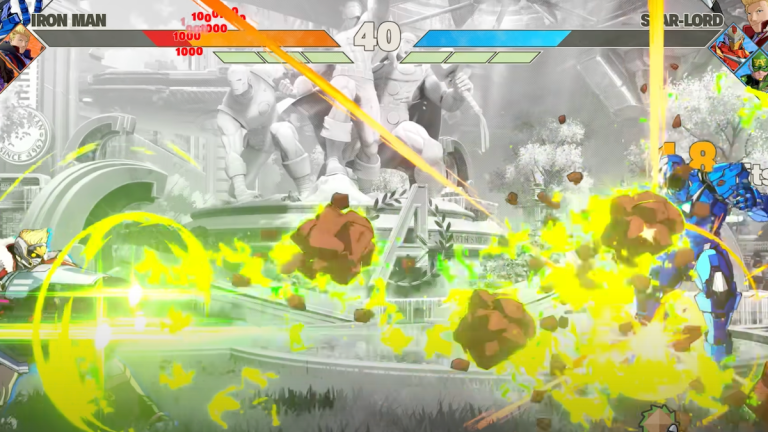Marvel Tokon: Fighting Souls Preview Teases an Exciting Future for Fighting Games
At Evo 2025, Arc System Works and Sony Interactive Entertainment provided the first hands-on preview for Marvel Tōkon: Fighting Souls.

Last year’s Marvel vs. Capcom Fighting Collection: Arcade Classics compilation notwithstanding, there hasn’t been a new Marvel fighting game since 2017’s Marvel vs. Capcom Infinite. That distinction is coming to an end with the upcoming fighting game Marvel Tōkon: Fighting Souls, developed by Arc Systems Works and published by Sony Interactive Entertainment in 2026 for the PlayStation 5 and PC. After its official announcement in June, an early version of the game received its first hands-on public preview at 2025’s Evolution Championship Series, or Evo, in Las Vegas.
Den of Geek was invited to participate in this Marvel Tōkon: Fighting Souls hands-on experience at Evo, sitting down for an extended preview guided by an SIE staff member. This early version of the game only featured one stage and a limited number of characters from the playable roster at this time, all of whom were previously included with the game’s announcement trailer. And judging by this preview, fighting game fans are in for something surprisingly unique yet accessible for newcomers of the genre.
Though Marvel Tōkon: Fighting Souls is a 4v4 fighter, the gameplay mechanics in how this tag-team battle unfolds is the most unexpected aspect of what has been shared from the title so far. Each of the characters holds a special role on the team based on the order in which they’re selected: the point fighter, the projectile assist, the vertical assist, and the team anchor. These characters can be brought in for various assist attacks and counters or tagged in and out, but the method in which players gain access to them is one of the more unique aspects of the game.
When the match begins, players each only have access to their point character and a single assist character, with the assist mechanic having its own meter. As players perform wall breaks on the edge of stages, echoing a similar mechanic from Arc System Works’ best-selling previous game Guilty Gear Strive, they gain access to more members from their selected team. This adds greatly to the underlying strategy of each fight, both in terms of positioning opponents where they could be vulnerable to a wall break and adding the importance of staying out of a corner to avoid benefitting the opposing player.
The fight mechanics themselves are reminiscent to anyone familiar with the gameplay in Guilty Gear or Dragon Ball FighterZ, with attack inputs being set to light, medium, heavy, and special attacks. Like both of those games, players can also launch into devastating super combinations from a string of these basic moves, so long as they have enough of their meter built up to fuel these attacks. However, it’s the team assist mechanic, including its intuitive implementation of counters, that sets Marvel Tōkon: Fighting Souls apart from preceding Arc System Works’ games, and lends greatly to the unpredictability of each fight, where the tide could turn at any moment.
The game’s visual presentation leans heavily into Arc System Works’ past experience with anime-influenced or anime-adapted designs, while keeping each Marvel hero and villain visibly familiar to the classic source material. Iron Man has a more mech-inspired design and Star-Lord looks like he could be right out of sci-fi shōnen anime, but their demeanor and moveset reflects the comic book iterations global fans know and love. This artistic approach extends to highly detailed level design, with even the New York City stage for the preview containing everything from nods to the Spider-Man mythos, even a silent cameo by Daredevil in his civilian guise as Matt Murdock.
Fan service aside, Marvel Tōkon: Fighting Souls just feels particularly satisfying whenever a successful assist combination or super move is executed and, given the game’s linking system, these moments come in fast and furiously. The game intuitively makes stringing together combos easy, but without feeling like it’s watering down the complexity or intensity of the experience itself. It’s a fine line to balance, especially for fighting game purists, but a strong reminder that overly complex mechanics are not a requirement for a good game, something Arc System Works has understood and employed effectively for years, making them the ideal developer for this project.
Any gamer expecting Marvel Tōkon: Fighting Souls to be a direct riff on the Marvel vs. Capcom series is going to be surprised at how different the two gameplay experiences are. Arc System Works and Sony are hard at work on a title that, while certainly a 2D tag-team fighting game focused on Marvel characters, feels fresh from anything that has come in the genre or using the iconic comic book property before. And like any fighting game worth its salt, Marvel Tōkon: Fighting Souls is fast-paced, fun, and easy to pick up and play, both to genre veterans and newcomers alike.
Developed by Arc System Works and published by Sony Interactive Entertainment, Marvel Tōkon: Fighting Souls will be released for PlayStation 5 and PC sometime in 2026.
